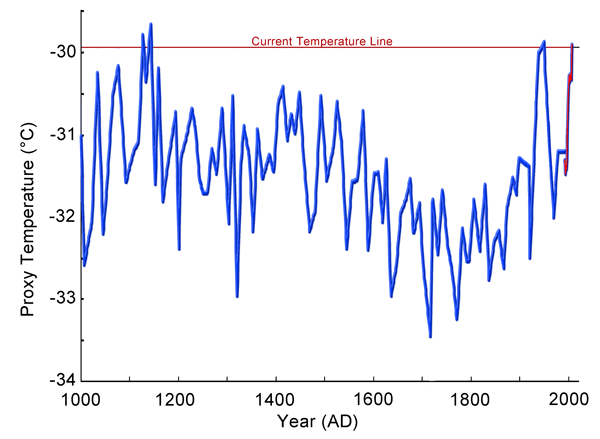GISP2 Ice Core, Greenland Summit
Reference
Kobashi, T., Kawamura, K., Severinghaus, J.P., Barnola, J.-M., Nakaegawa, T., Vinther, B.M., Johnsen, S.J. and Box, J.E. 2011. High variability of Greenland surface temperature over the past 4000 years estimated from trapped air in an ice core. Geophysical Research Letters 38: 10.1029/2011GL049444.
Figure 1. The pre-1950 reconstructed Greenland temperature derived from the δ15N and δ40Ar data (blue line) and the post-1950 temperature (red line) derived from the "forward model" of Kobashi et al. (2010: Climatic Change 100: 733-756). Adapted from Kobashi et al. (2011).
Reference
Kobashi, T., Kawamura, K., Severinghaus, J.P., Barnola, J.-M., Nakaegawa, T., Vinther, B.M., Johnsen, S.J. and Box, J.E. 2011. High variability of Greenland surface temperature over the past 4000 years estimated from trapped air in an ice core. Geophysical Research Letters 38: 10.1029/2011GL049444.
Description
Working with the GISP2 ice core from the Summit region of central Greenland (72°36'N, 38°30'W), Kobashi et al. reconstructed Greenland surface snow temperature variability over the past 4000 years with a method that utilizes nitrogen and argon isotopic ratios (δ15N and δ40Ar) of these gasses trapped within air bubbles in the ice core. The results of this effort are plotted in the figure below, where it can be seen that the peak temperature of the Medieval Warm Period is about 0.3°C greater than the peak temperature of the Current Warm Period.

Figure 1. The pre-1950 reconstructed Greenland temperature derived from the δ15N and δ40Ar data (blue line) and the post-1950 temperature (red line) derived from the "forward model" of Kobashi et al. (2010: Climatic Change 100: 733-756). Adapted from Kobashi et al. (2011).




